
Original Link: https://www.anandtech.com/show/5556/lian-lis-pc90-the-hammer-strikes-hard
Lian Li's PC-90: The Hammer Strikes Hard
by Dustin Sklavos on February 21, 2012 12:00 AM EST- Posted in
- Cases/Cooling/PSUs
- mid-tower
- Lian Li
Introducing Lian Li's PC-90
The majority of the enclosures from Lian Li that we've tested so far have been designed for mini-ITX and micro-ATX builds, but today we have on offer one of their premium full ATX cases, and it's a promising one indeed. Lian Li's PC-90, which they dub "The Hammer," is designed to support HPTX and XL-ATX motherboards while being smaller and lighter than most other enthusiast cases in its class. And while we'd hesitate to call it diminutive, it's definitely smaller than you'd expect.
.jpg)
Lian Li aims to offer a lighter, more austere shell for high performance systems in the PC-90, and we can tell you they've been very successful. Without giving too much away, Lian Li's traditional brushed aluminum shell and accompanying aesthetics meet an old school ATX enclosure design complete with top-mounted power supply in a way that offers an intriguing alternative to the larger, bulkier enclosures we're used to reviewing for this bracket. Here's the brief overview.
| Lian Li PC-90 Specifications | ||
| Motherboard Form Factor | HPTX, E-ATX, XL-ATX, ATX, Micro ATX, Mini ITX | |
| Drive Bays | External | 2x 5.25" |
| Internal | 6x 3.5", 6x 2.5" | |
| Cooling | Front | 2x 140mm intake fan |
| Rear | 1x 120mm exhaust fan | |
| Top | 1x 140mm fan mount | |
| Right | - | |
| Bottom | - | |
| Expansion Slots | 10 | |
| Front I/O Port | 2x USB 3.0, headphone and mic jacks, eSATA | |
| Top I/O Port | - | |
| Power Supply Size | ATX | |
| Clearance | 15.5"/400mm (Expansion Cards), 170mm (CPU HSF), 300mm (PSU) | |
| Weight | 14.7 lbs (6.7 kg) | |
| Dimensions | 9.1" x 19.9" x 19.3" (230mm x 505mm x 489mm) | |
| Price | $200 | |
The PC-90 certainly isn't cheap, but it's most definitely an intriguing design. At just 14.7 pounds it's positively svelte compared to other enthusiast-class enclosures like Cooler Master's Cosmos II or SilverStone's FT02. That light weight owes to the largely aluminum shell and minimal use of steel in the framework. There's also a respectable amount of depth to the case, but as you'll see, that depth is needed.
In and Around the Lian Li PC-90
While Lian Li does have the odd stylized enclosure design, their brushed aluminum cases tend to really epitomize simplicity of style. End users looking for something with a little more flash are sure to be disappointed, and nowhere is that more apparent than with the PC-90.
Externally, the PC-90 is almost entirely black brushed aluminum, with the rear and bottom of the case still sporting the typical silver sheen. The front features two external 5.25" drive bays, one of which has an included bezel cover. Connectivity is handled by two USB 3.0 ports that use an internal motherboard header, the standard HD audio connectors, and an eSATA port. The eSATA port is a nice touch, but I feel like USB 3.0 largely supplants it and Lian Li can probably dispense with it in a future revision. The power button is a sliver of rubber with a blue LED behind it, while the reset button has the red IDE activity LED behind it.
.jpg)
On the top of the case, Lian Li has a plate that can be removed to install a 140mm fan inside the enclosure, but this seems like another useful feature that may not be as useful in practice; you'll see from the test results later on that cooling is not one of the PC-90's weaknesses. This fan mount also winds up being planted squarely between where the power supply and optical drive are expected to go, potentially causing clearance problems later on. As a result it's probably better left occupied by the plate, which means you just get a cut-out shape marring the top of your case rather than something you're likely to use.
When we get to the back, we see Lian Li employs a mounting bracket for the PSU to allow for easy installation; this tends to be more common in designs with top-mounted power supplies. Everything else is bog standard, with a 120mm exhaust fan and ten expansion slots with ventilated covers.
.jpg)
Of course, once you remove the side panels (each secured with two thumbscrews and the main side panel additionally able to be secured with a padlock), you'll see where Lian Li's engineers took some liberties with the classic ATX enclosure layout. There's a top rail for supporting the power supply, and then a large motherboard tray with a cutout for cooler backplates.
.jpg)
Yet you can also see how Lian Li was able to cram so much in the enclosure: there's no space behind the motherboard tray for routing cables, and drives are instead mounted to a pair of plates and either pressed up against the side panel of the case or stretched internally on the undersides of the plates; you'll see on the next page how it all comes together. There's also a third pair of plates in the center that's theoretically intended for routing cables, but in practice winds up being largely superfluous. Thankfully you can choose to dispense with any or all of these plates, using only what you need, as they're completely removable.
The internal fans also all use 3-pin fan headers and all come connected with 3-pin to molex adaptors, allowing you to choose how you want to power them. Likewise, Lian Li also includes a USB 2.0 adaptor for the internal USB 3.0 connector.
My experiences with the previous Lian Li enclosures I've tested left me a little bit wary and skeptical of the design, but thankfully the PC-90 proves to be a lot more logical (and easy to put together) in assembly than would first appear.
Assembling the Lian Li PC-90
I have to be honest, what Lian Li packages with the PC-90 is pretty daunting, and I think a lot of it really could've been excised without harming the overall package. There is such a thing as too much, and the PC-90 finds it. Lian Li includes a plastic case for holding screws, a nice touch, but also includes several confusing plastic pieces that you'll find are supposed to be snapped into the middle plate to help brace expansion cards. These are liable to be used for bracing extra-long workstation cards, but it still feels excessive and worse, needlessly confusing.
.jpg)
Thankfully, if you can parse out what Lian Li includes, assembly of the PC-90 is actually fairly simple and logical. The motherboard tray comes with standoffs for an ATX motherboard already installed, and once you take those drive and cable routing plates out things are a lot simpler. There's plenty of space for installing the motherboard as well as wiring it up and installing any expansion cards you may have. Better still, Lian Li includes special thumbscrews for mounting the motherboard, making it that much easier.
Where assembly is a little out of order with the PC-90 is when installing storage drives. Those go on the plates and the plates go in last, so before you do that, you'll want to install the power supply and optical drive. The power supply goes in easily enough; remove the mounting bracket from the back (attached with four thumbscrews), screw the bracket on to the PSU, and then slide the PSU into the enclosure and secure it. You can actually remove the top panel of the PC-90 if you're so inclined, but it's not necessary.
.jpg)
Installing the optical drive involves popping the front panel off (it's designed to come off easily but also stay on securely). From there, you need to remove the fascia for the optical drive (held on by two screws), then screw in four rubber grommets and screws into the sides of the drive. Slide it in on the rails until it's in as far as it can go, then replace the fascia. The problem with this design is the same one that plagued the other Lian Li systems I tested: the button on the fascia just doesn't line up with the button on our Blu-ray drive, and there's no simple way to correct it. Understanding that not using the fascia might break up the PC-90's aesthetic, I think it's still a sacrifice worth making.
.jpg)
Before installing the 3.5" and 2.5" drives, you'll want to make sure everything else is wired up first, and you may even want to have the power and SATA leads ready for the drives. The drives are mounted by using thumbscrews with rubber grommets; the drives pop into the plates and slide into a locked position, and it's actually reasonably secure. You'll want to consult the manual on how exactly to orient the drives, though, lest you risk installing them the wrong way the first time like I did. Lian Li wants the cables to be routed through the center plates (and accompanying routing holes), but I honestly felt like this was an untenable solution. End users may be better off removing the center plates outright.
.jpg)
Lian Li's design for the PC-90 does feature one major shortcoming, and that's cable management. Given the way they intend components to be installed in the enclosure I have a hard time seeing how they could've done a much better job, but it does bear mentioning that much like many older enclosure designs there are going to be a lot of floating cables. Lian Li's engineers pay lip service to the idea of routing cables behind the motherboard tray, but realistically there's virtually no space back there.
.jpg)
I'll confess that once I got everything put together, I was skeptical of how well the PC-90 would perform. This straightforward wind tunnel design can be absolutely fantastic (as SilverStone's smaller TJ08-E proves), but with all of the floating cables potentially obstructing airflow and few allowances for handling them, it's easy to see how the PC-90 could lose a lot of that cooling potential. Thankfully it acquitted itself very well when the time came to do thermal testing.
Testing Methodology
For testing ATX cases, we use the following standardized testbed in stock and overclocked configurations to get a feel for how well the case handles heat and noise.
| Full ATX Test Configuration | |
| CPU |
Intel Core i7-875K (95W TDP, tested at stock speed and overclocked to 3.8GHz @ 1.38V) |
| Motherboard | ASUS P7P55D-E Pro |
| Graphics Card | Zotac NVIDIA GeForce GTX 580 (244W TDP) |
| Memory | 2x2GB Crucial Ballistix Smart Tracer DDR3-1600 |
| Drives |
Kingston SSDNow V+ 100 64GB SSD Western Digital Caviar Black 1TB SATA 6Gbps Samsung 5.25" BD-ROM/DVDRW Drive |
| CPU Cooler | Zalman CNPS9900 MAX with Cooler Master ThermalFusion 400 |
| Power Supply | SilverStone Strider Gold 750W 80 Plus Gold |
A refresher on how we test:
Acoustic testing is standardized on a foot from the front of the case, using the Extech SL10 with an ambient noise floor of ~32dB. For reference, that's what my silent apartment measures with nothing running, testing acoustics in the dead of night (usually between 1am and 3am). A lot of us sit about a foot away from our computers, so this should be a fairly accurate representation of the kind of noise the case generates, and it's close enough to get noise levels that should register above ambient.
Thermal testing is run with the computer having idled at the desktop for fifteen minutes, and again with the computer running both Furmark (where applicable) and Prime95 (less one thread when a GPU is being used) for fifteen minutes. I've found that leaving one thread open in Prime95 allows the processor to heat up enough while making sure Furmark isn't CPU-limited. We're using the thermal diodes included with the hardware to keep everything standardized, and ambient testing temperature is always between 71F and 74F. Processor temperatures reported are the average of the CPU cores.
For more details on how we arrived at this testbed, you can check out our introductory passage in the review for the IN-WIN BUC.
Last but not least, we'd also like to thank the vendors who made our testbed possible:
Thank You!
We have some thanks in order before we press on:
- Thank you to Crucial for providing us with the Ballistix Smart Tracer memory we used to add memory thermals to our testing.
- Thank you to Zalman for providing us with the CNPS9900 MAX heatsink and fan unit we used.
- Thank you to Kingston for providing us with the SSDNow V+ 100 SSD.
- Thank you to CyberPower for providing us with the Western Digital Caviar Black hard drive, Intel Core i7-875K processor, ASUS P7P55D-E Pro motherboard, and Samsung BD-ROM/DVD+/-RW drive.
- And thank you to SilverStone for providing us with the power supply.
Noise and Thermal Testing, Stock
While I didn't have high hopes for the Lian Li PC-90's acoustic performance due to the lack of allowances made for noise dampening, I was fairly optimistic about how well the pair of 140mm intake fans would handle thermals. As it turned out, that optimism was well justified.
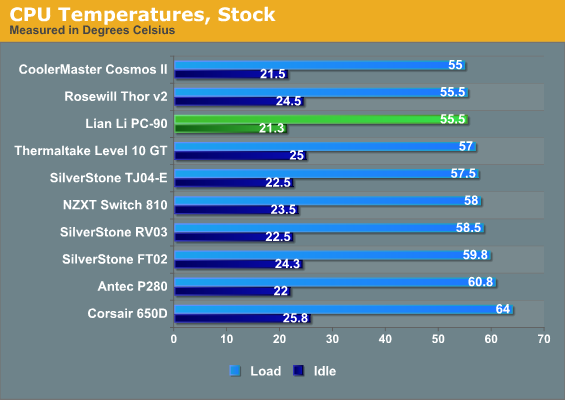
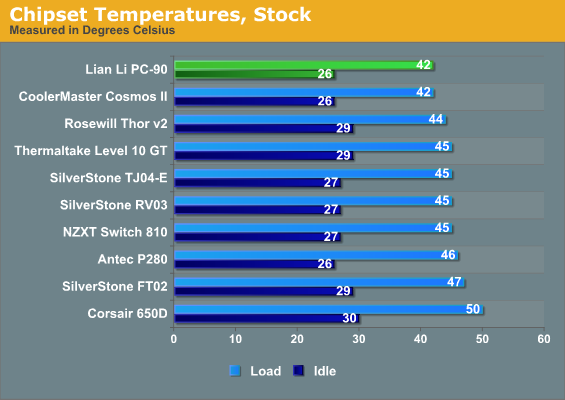
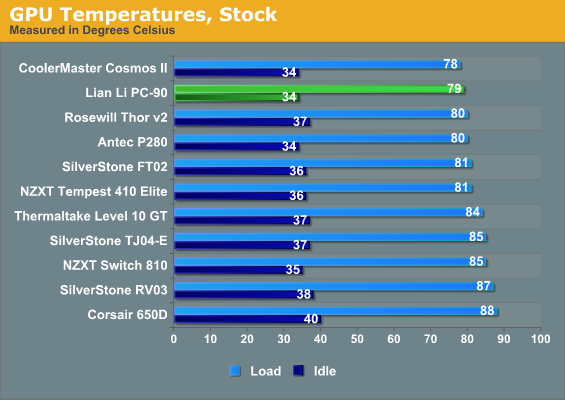
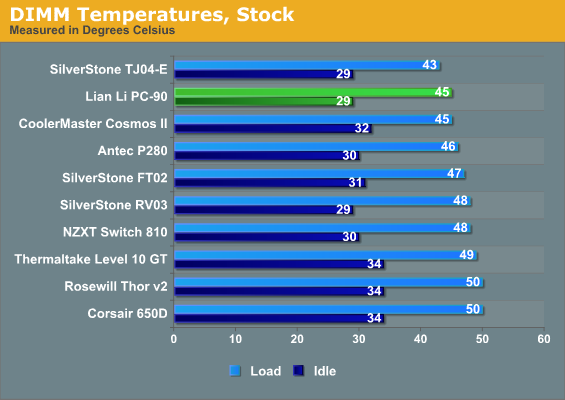
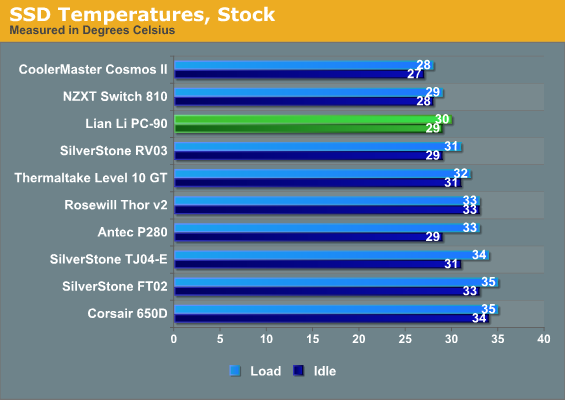
It's important to understand what Lian Li is achieving in the PC-90 compared to the other enclosures we've tested. Only the Cosmos II is really able to hang with it, and that enclosure is three times as heavy, $100 more expensive, uses more and larger fans, and has a compartmentalized internal design.
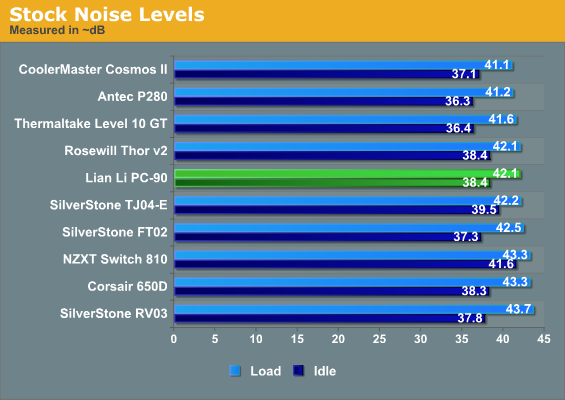
These things in mind, the Cosmos II is admittedly also quieter. These stock settings don't produce a whole lot of stress, though, and our enthusiast-class enclosures here don't have much of a problem keeping pace with each other acoustically under full load.
Noise and Thermal Testing, Overclocked
As always, our overclocked settings separate the men from the boys. Lian Li's design in the PC-90 acquitted itself admirably in our stock settings, and as you'll see, the two intake fans and single exhaust are more than up to the task of keeping our system cool even when heavily overclocked.
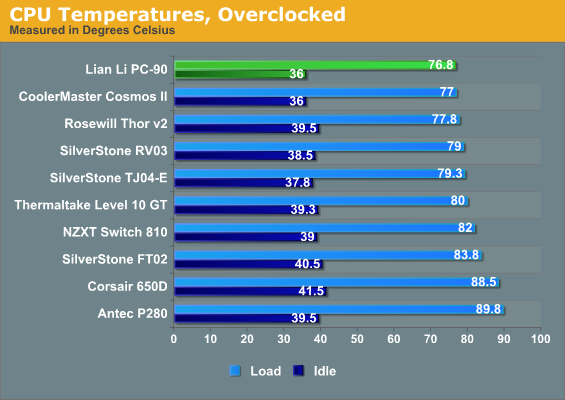
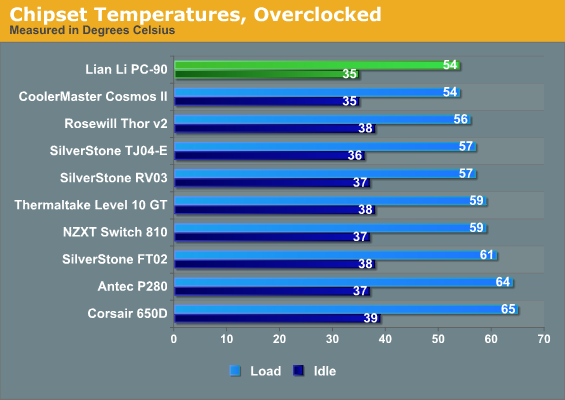
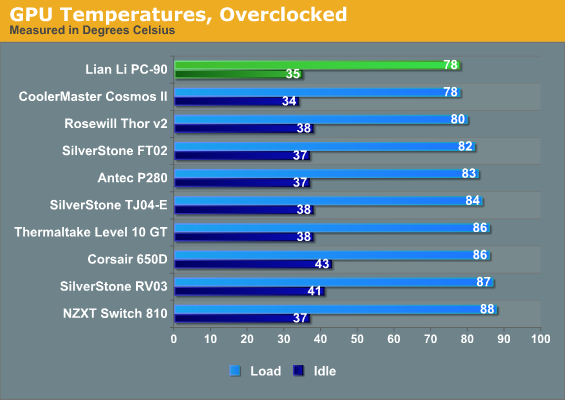
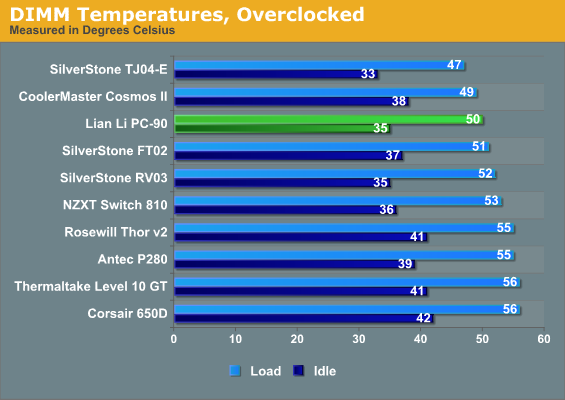
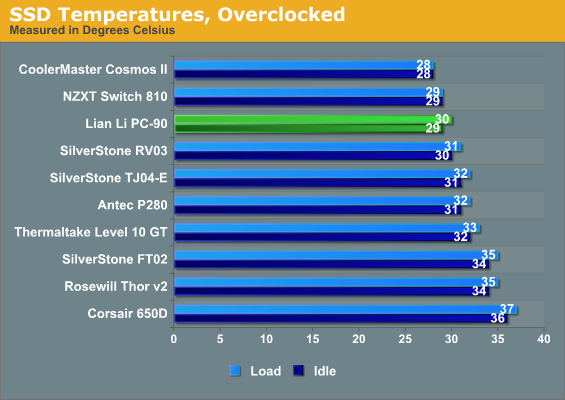
It's virtually a clean sweep for the PC-90. Lian Li is able to do more with less than the competing enclosures are; it still manages to hang with the Cosmos II and it seems clear that the PC-90 can handle the kind of dual-CPU workstation it appears to have been designed for.
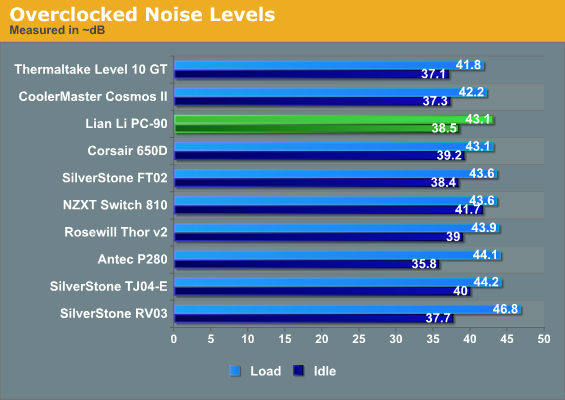
Even noise levels are actually decent. While idle noise is less than ideal, a proper implementation of fan control on the motherboard (or even a dedicated fan controller) could probably take the edge off of that. Meanwhile, load noise isn't great, but it isn't terrible either. Despite making no allowances for acoustics the way competing cases like the Level 10 GT, Cosmos II, and SilverStone FT02 do, Lian Li's PC-90 is still able to compete on noise (and flat out win on thermals).
Conclusion: Workstation Class
If you're after pure performance from an enclosure, Lian Li's PC-90 is an excellent place to start looking. Despite quibbles with the assembly, the PC-90 is able to achieve in a smaller space and with less resources and weight what larger enclosures like the Cooler Master Cosmos II and Thermaltake Level 10 GT can do. Lian Li's enclosure almost makes competing cases feel over-engineered by comparison. Yet if we look closer at all of these designs, it becomes fairly clear who each of these cases is designed to cater to.
Lian Li's enclosure has the performance to appeal to enthusiasts, but virtually no allowances are made for liquid cooling of any kind. Certainly the enterprising user could install a 280mm radiator in the front, but similar to the brackets included with the SilverStone FT02, this is something an individual could but probably shouldn't do. The PC-90 is an air-cooling case first and foremost. Once you take into account the incredibly minimalistic exterior and the slightly more involved assembly, it seems clear Lian Li is gunning for the PC-90 to be used as a workstation enclosure as opposed to a high-end gaming system. Certainly it can handle either and the performance is definitely there, but it's a lot easier to see the PC-90 under a desk in an office than, say, a Level 10 GT.
With all that said, I still waffle on some of Lian Li's design decisions. I feel like their mounting system for storage drives at least make more sense here, but the optical drive mounting system, and particularly the drive fascia, needs to be revised. There's no shame in needing to use tools to assemble a desktop; toolless allowances are nice, but sometimes it's better to just go back to basics. I expect some users will probably worry about hot air flowing from the interior of the enclosure up through the power supply's fan, while others will be concerned about outward-mounted hard drives passing vibrations through the side panel and thus amplifying access noise. These aren't invalid concerns, but I wouldn't let either one stop me from using the PC-90. Hot air going through the power supply might very well wind up being a serious issue, but mechanical hard disks can always be mounted on the interior sides of the drive plates to help alleviate vibration.
There is, of course, also the price tag. At $199 the PC-90 is an expensive piece of kit, but at the same time I do find myself having difficulty recommending alternatives. This is a situation that may very well come down to personal preference. End users looking to save some dosh can always pick up Rosewill's Thor v2, while users looking for a little more flash are going to have access to the Cosmos II and Level 10 GT. There are good options for each user willing to invest in a quality case, but $199 feels too steep for the PC-90. The performance absolutely matches the price tag, but the materials and overall build quality don't quite line up. At $149 it would be much easier to recommend. As I've said on other expensive parts and peripherals, I wouldn't fault anyone for buying the PC-90, but it could (and should) be less costly.

_thumb.jpg)
_thumb.jpg)
_thumb.jpg)
_thumb.jpg)
_thumb.jpg)
_thumb.jpg)
_thumb.jpg)
_thumb.jpg)
_thumb.jpg)
_thumb.jpg)
_thumb.jpg)
_thumb.jpg)






